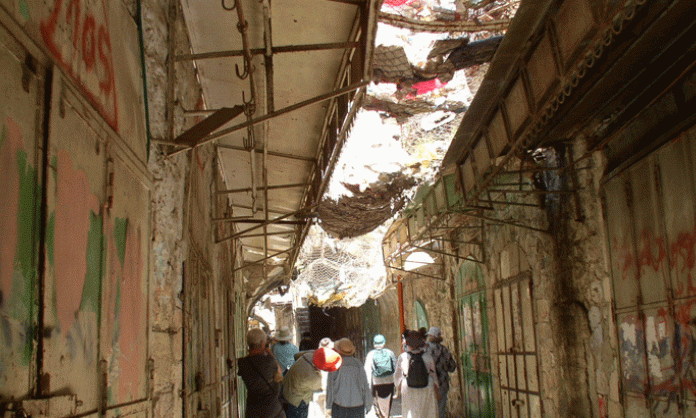Jameela Jubran had not set foot in Palestine for 33 years. But the death of her father last year, and a desire to see the truth about the Israeli occupation, drove her to return to her homeland. What she found, alongside the horror of Israeli occupation, was an inspiring new union movement. Red Flag’s Corey Oakley talked to her about the experience.
The most iconic images of the Palestinian resistance are those of fire and fury. The mass demonstrations, the armed fighters and most of all the kaffiyah-clad young people staring down Israeli tanks with nothing but rubble from the street.
But there is another side to the resistance. A quiet, enduring defiance; a refusal to relinquish hope, identity and dignity in spite of all the years of dispossession. The grandmothers who still hold the keys to the home they were evicted from so many decades ago. The children who have never seen their homeland, but proudly assert “I am a Palestinian”.
It is this element of the Palestinian struggle I am reminded of when Jameela tells me how she took a clump of dirt from her father’s grave in Florida, all the way back to her family town Beit Sahour, near Bethlehem.
“It is a saddening thing for me to remember that he was buried in America, away from Palestine, the land that he loved, and that he instilled love for in us”, she says. “I felt like I wanted to do something symbolic to unite him with the land. So I asked my daughter to bring some soil from his grave in America, and I took it with me. She brought it from America to Australia, I took it from Australia to Jordan, and from Jordan I crossed the bridge and took it with me to Palestine, and I sprinkled the soil on the graves of my grandparents, his own mum and dad.
“I know he is not there, but every minute I was walking around in Palestine, often I would have tears in my eyes, saying to myself, ‘Baba, I am doing this for you, seeing this for you’.”
The Palestine of today is very different to what Jameela remembers. In 1980 there was, as now, an occupation. But it was possible to move relatively freely around the occupied territories, to travel from the West Bank to Gaza, and even into Israel itself – “Palestine of ’48”, as Jameela calls it.
Today the West Bank has been so broken up by checkpoints, Jewish-only settlements and segregated roads that any semblance of normal life is impossible. Journeys that once took 10 minutes can now take hours. Travelling from one part of town to another can mean negotiating numerous Israeli checkpoints.
‛Ghost Town’
Of all the places Jameela visited, Hebron was the “the saddest place”. Hebron is the only Palestinian city in the West Bank with a Jewish settlement in its centre. Four thousand Israeli soldiers severely restrict the movement of tens of thousands of Palestinian residents, all in order to defend 400 settlers who have taken over the heart of the city.
“The old city is known now as ‘Ghost Town’”, Jameela says. “It is just like a military zone. To make room for these 400 settlers, they evacuated 1,800 shops and the houses above them. The shops are closed by metal gates, which are welded shut, so the owners cannot come back.”
Forty-two percent of the apartments in central Hebron have been abandoned by their occupants. For those who remain, it is a terrifying existence. Raja`a Abu `Ayesha, one of those who stayed, says, “Our house is like a cage. It is completely fenced in, including the entrance. My grandfather set it up that way to protect us, after settlers broke all our windows. Our house looks like an island surrounded by a sea of settlers, soldiers and a violent atmosphere.”
Shuhada Street, the once bustling centre of the old city, is deserted. Palestinians are not allowed to enter. With an Australian passport, Jameela could have walked down the street. “Mohammad, who was showing us around, told us, ‘You can walk if you want – I cannot walk.’ We thought to ourselves: ‘No. Mohammad, who lives inside the old city of Hebron, cannot walk this street. So we are not walking it.’”
Among the most sickening indicators of the attitude of the settlers are the rubbish-filled wire nets (see photo) that string above the narrow streets, below the houses now occupied by settlers. Jameela explains, “As people walked down the street they kept having rubbish thrown at them by the settlers – nappies, old rubbish, empty milk bottles, other bottles, anything.
“It was disgusting. So the NGOs, along with pro-Palestine activists, they helped the Palestinian residents build wire netting above the street. So now you as you walk down the street you see the rubbish trapped above people’s heads in the narrow passage leading up to the mosque.”
This is the everyday contempt that the heroes of “civilised” Israel display to the people whose land they occupy.
It is difficult to speak out openly, and not just because of the Israelis. Jameela tells me about the reaction when she challenged a Palestinian policeman on a bus about their role in enforcing the occupation. “I looked at people around me, the Palestinians, and they were looking at me and mouthing ‘Shut up, shut up’, and putting their hands across their mouths.
“They are terrorised by the Palestinian police, who are terrorised by the Israelis. The Palestinian Authority is intimidating its own people into silence. People cannot speak their mind – I was only able to because I have an Australian passport.”
But in spite of everything, the resistance does continue. There are many popular committees and local groups organising across the villages and towns of the West Bank. Some of the most visible – and the most independent from the Palestinian Authority – have been the protest movements against the Apartheid Wall in Bi’lin and other villages. But there are also signs that a new workers’ movement is emerging.
The centre of this movement is Tulkarem, a city in the north-west of the West Bank. “Tulkarem embodies all the suffering of the Palestinians”, Jameela says. “Right on the wall. It is choked not only by the wall, but by the Israeli factories, which were established in the early 1980s.”
Six-month strike
Tulkarem is in Area C, one of the parts of the West Bank completely controlled by Israel. Some Israeli capitalists find it cheaper and easier to build their factories there.
“Each factory acts as a settlement”, Jameela explains. “Confiscating land and terrorising the people by terrorising their health.”
These factories produce all kinds of potentially harmful materials. Chemical fertilisers, plastics, polish, paints.
One of the most notorious factories is Sol Or. Although it employs only 90 workers, three have recently died of cancer, almost certainly attributable to the poisonous bromine gas produced there, and the appalling health and safety conditions. Several other workers have died from burns.
The Israeli capitalists who built factories there did so because they could evade Israeli taxes and pay workers the absolute minimum – 50 shekels (about A$15) a day, which is way below the poverty line.
But this year the situation has been transformed. Jameela recounts: “The workers organised to take strike action – they went out for six months. The strike continued until the company broke down completely, and the new management had to negotiate with the workers and give them their health conditions, their back pay and everything else.
“The ripple effect of this strike was enormous. Six other factories wanted to strike, but their owners told them, ‘Don’t strike, we will give you everything you want.’”
A key part of the strikes’ success was the role played by a new union organisation, the Palestine New Federation of Trade Unions.
“They are completely independent from the Palestinian Authority”, Jameela says. “Some of the delegates are either former members of leftist organisations or still members. One activist in the union is on the central committee of the Palestine People’s Party. But, he told me, he refuses to impose the agenda of certain organisations over defending workers’ rights.”
This is an important positive in a context where the Palestinian left has often acted as a loyal opposition to Fatah, the main grouping in the PA, and most of the other unions are under the influence of the PA. “People started to want something else”, Jameela explains. “Because of their independent stance, these unions have gained a following, especially after these big strikes. Now they have 5,000 members.”
This new movement is still in its early stages. But it provides a glimmer of hope for the future. I asked Jameela how confident she was that a new mass movement would erupt in the territories – the much hoped for third intifada.
She told me the response she received when she asked the same question of activists and union organisers in the West Bank. “It is not a question of if. It is a question of when.”











